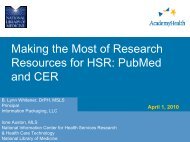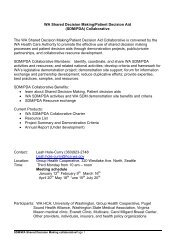Ohio Health Quality Improvement Plan
Ohio Health Quality Improvement Plan
Ohio Health Quality Improvement Plan
You also want an ePaper? Increase the reach of your titles
YUMPU automatically turns print PDFs into web optimized ePapers that Google loves.
Pa t ie n t Centered Me d ic a l Ho m e sPCMH Payment ModelsThe PCMH Task Force should develop and promote public policies that create economic incentives and financingstrategies that support and encourage implementation of the PCMH approach. Incentives and strategies should focus onensuring that all <strong>Ohio</strong>ans have access to appropriate and high-quality primary care. Consideration should be given to:• Researching, including identifying pros/cons and implications for <strong>Ohio</strong>, the different PCMH payment reformoptions. While there is no clear consensus or evidence to support a single, best financing mechanism, there is generalagreement on a number of key attributes, including the following:◦◦ Payment reform is a critical component of any effort to re-design primary care and promote the PCMH approach;◦◦ Funding mechanisms must be transparent to providers, payers, and consumers;◦◦ Funding mechanisms must provide reimbursement for services and activities not currently covered undertraditional fee-for-service (FFS) payments. These include coordination of care, improved access, and caremanagement;◦◦ Funding mechanisms must reward providers for improving health outcomes, improving quality of care, anddecreasing cost through better preventative and disease management services;◦◦ Payers must recognize that there are transitional and start-up costs associated with moving to the PCMHapproach, including investments in health information technologies;◦◦ Develop incentives to ensure providers in medically underserved areas adopt the PCMH approach and havesufficient resources to do so; and,◦◦ Regardless of the payment mechanism, resources and shared savings will need to be redirected to optimize thelevel of primary care service.• Determining how publicly funded health care programs and benefits (e.g., Medicaid, FQHCs, state and countyemployees’ health benefits, worker’s compensation) can be used to encourage/stimulate the development of thePCMH approach in <strong>Ohio</strong>.• Identifying funding (e.g., AHRQ) and developing finance strategies that promote the creation of regional10collaboratives.Primary Care WorkforceIn collaboration with state agencies, provider/practitioner organizations, educational institutions and consumer groupsthe HCCQC should coordinate efforts to expand and enhance the primary care workforce in order to support theimplementation of the PCMH approach. Consideration should be given to:• Defining the clinical and support professionals needed for primary care and PCMH;• Fortifying the pipeline to primary care careers, and fostering opportunities for students to participate in primary careeducational and training experiences, while also increasing exposure to primary care for health professional students;• Ensuring that there is an adequate supply of programs and teachers to train the future primary care workforce;• Creating opportunities and incentives for health professionals entering primary care careers, including placement andtraining opportunities in underserved areas, and training as members of interdisciplinary teams;• Revising the current provider payment system to reflect the essential role and value of primary care in the health caredelivery system, attract more primary care professionals, improve access to primary care and encourage coordinated,team-based care;• Reviewing state scope of practice laws to improve collaborative practices and improve location options for all primarycare professionals;• Designing interdisciplinary training programs (e.g., health care education, CME/CE) that target the needs of thePCMH approach and support care of special needs populations (e.g., older adults, behavioral health, chronicconditions, long term disabilities) receiving care through the PCMH;• Increasing the awareness of providers/practitioners as to how culture affects who seeks treatment and where they seektreatment as well as the understanding of cultural bias; and• Developing and enhancing curricular integration of informatics in health care with emphasis on population-basedcare, quality and safety, and evidence-based practice.










